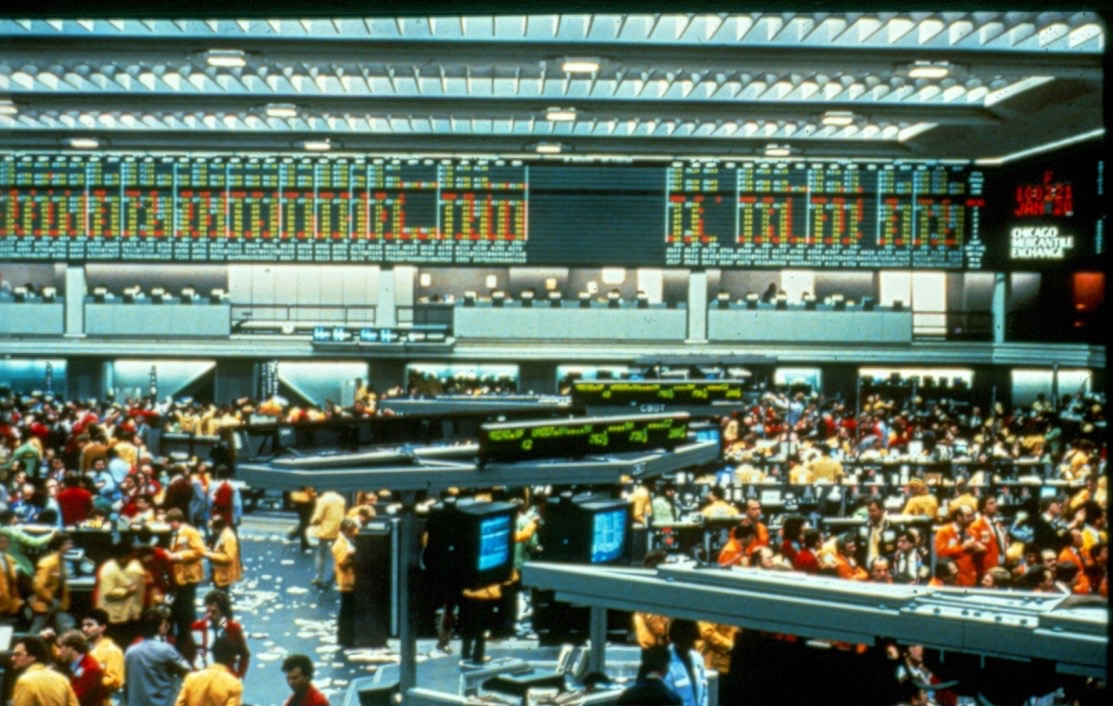Archives
Reuters technical development chronology 1985-1989
Monday 27 July 2015
1985
- Although some time since the strike, relations continue to be strained in London between those who obeyed the union call and those who did not. The concession of a nine-day working pattern is felt by many to be too big a productivity hit. With all the new work flowing into the group a proposal is made to expand the Geneva centre to include a new development group and eventually wind down London. This is read with interest but never approved as being too expensive and risky.
- Following a period of familiarity, the standard Rich video switching technology is thought much too expensive. A cheaper switch is developed, the Colour Video Switch (CVS), which is installed in large quantities in Midland Bank for their new 130-workstation trading room. Each position has four colour screens fed by 23 different information sources. Unfortunately the CVS doesn’t work properly when installed. Further, the number of Rich bids using the new untried component is causing a potential manufacturing backlog for a device that doesn’t yet work. Many panicky man-hours later the CVS is “repaired” and declared functional. It is reinstalled in the nick of time at Midland over several weekends. Manufacturing contracts are established in every small manufacturing enterprise in southern England to meet the other installation commitments. They were met. Very thin ice.
- The Contributed Gateway Processor is developed for Barclays allowing data to be contributed automatically. It is loosely based on the RTF hardware and software environment but with a highly complicated set of rules to avoid overloading Monitor and without inconveniencing the client (too much).
- Data is successfully transmitted from US exchanges to test environments via the fledgling IDN and the ECS-2 satellite. Geneva is the first centre to receive the signal.
- IDR is selected as the supplier of all terminals and concentrators for IDN.
- Rich is acquired following several years of marketing agreements.
- RNA implements SII System 55 and replaces the original news editing system installed nearly 12 years earlier. London follows shortly afterwards and decommissions MS-11B which didn’t last that long.
- The second generation Small Dish (SDS-2) service is launched in RNA offering a US domestic money service. It uses a new generation of two-foot dishes to receive the service via a channel on one Galaxy 3 transponder. The IDR-designed terminal offers split screens on 80x24 pages for the first time but the data stream is limited to 19.2 kbs which restricts the products delivered. It offers a datafeed output using a newly-defined protocol known as Marketfeed. This will later evolve into the standard for all datafeed products.
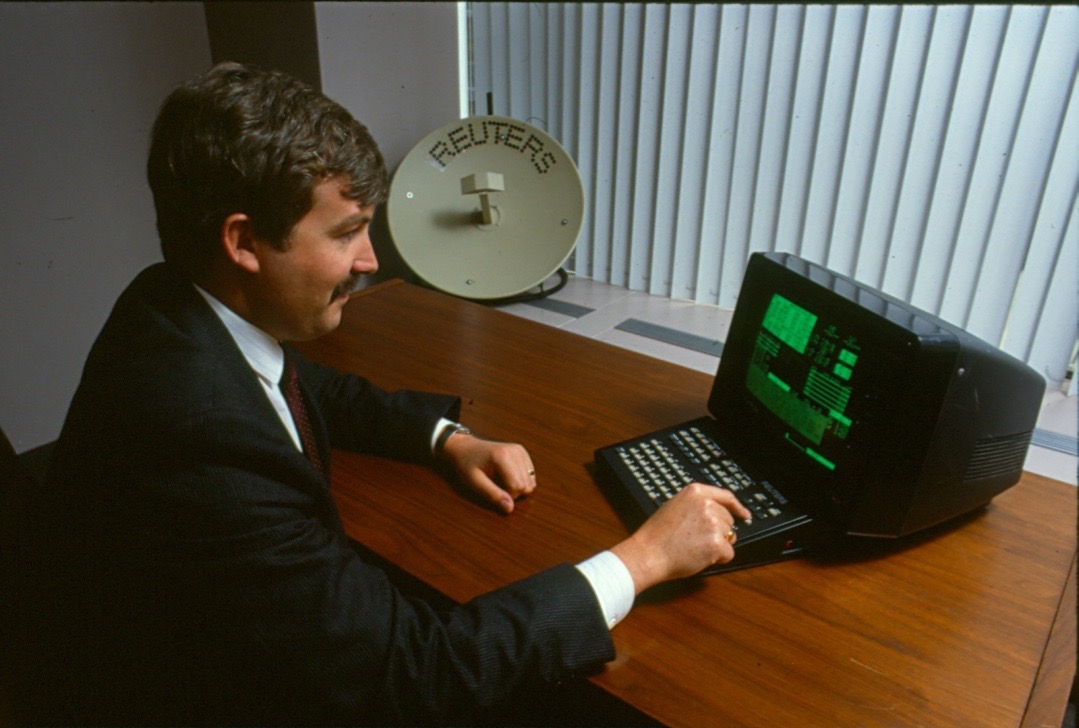
PHOTO: Tim Hillyar with SDS-2
- London development is rehoused in Maple/Centros, an old electronic components warehouse near Finsbury Square, having outgrown Great Sutton Street.
- The Automated Matching System project starts in RNA. As with Dealing a prototype is planned for proof of concept and as a marketing tool. The goal is a generic matching system applicable to a variety of markets. First release is planned for August 1986. First products are US government securities, with foreign exchange as a second phase. This is all terribly ambitious, especially as a raft of never before tried software components with a brand new network is proposed. The generic platform proceeds under the project title of Reuters Dealing Trading System (RDTS).
- Reuters and AAP announce the development of ADN (Australian Data Network). A set of services is to be carried over an internal broadcast network implemented by the jointly owned subsidiary ComCo. It will use a combination of IDN and Rowgrabber. Good luck with that.
- Communications innovations of this era for service delivery include the use of Rowgrabber over a cable network in San Francisco and use of TV scan lines in France.
- A pilot project starts with the Carnegie group to automate the categorisation of news stories. It falters because of the difficulty of integration with the proliferation of editorial systems. It later surfaces as part of the Country Reports service.
- Japan launches the first Japanese language financial service.
- News Retrieval adds page chaining so that clients can receive pages of news in sequence if the item runs to more than one page.
- New York development get a new toy in the form of the top of the range VAX 8600 for the quotes processing systems. They provide a theoretical throughput of 200 updates per second.
- The joint venture with ADP/GTE/Ultronic is terminated leaving Reuters free to sell Equities services in the United States.
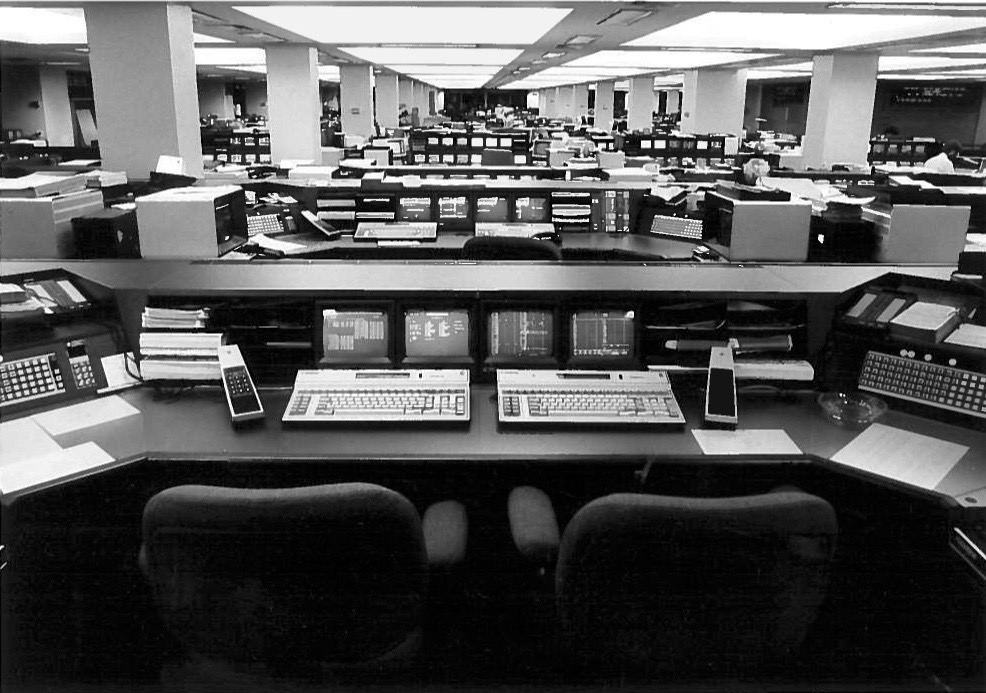
- Germany pursues the development of a Branch Data Feed which combines market data and a client application from an IBM mainframe on the same screen. This is for the German banks who are wedded to IBM mainframes for their in-house systems. It evolves into a successful product offering, renamed MPAS (multi-port access system), over the next few years. The Branch Data Feed and the Japanese language service are the first significant regional developments and show that these are possible outside the main development centres.
PHOTO: An early RIch CIS dealing room at Chemical Bank, 1985
- The first reasonably priced laptops become available.
- Local data centre infrastructure for IDN is rolled out in Geneva and Frankfurt and it works.
- The Advanced Reuter Terminal (ART) is launched. In development for less than a year, it uses an early version of Windows software (Version 1.0). On the screen, windows of information can be set up and manipulated with mouse and keyboard. It requires a dedicated 9600 baud connection to Monitor which is a lot for that era and means deployment is expensive compared to current financial models of cost per connection. The latest technology impresses all who see it but behind it all is a creaking 1970s network.

- Dealing finally appears in Tokyo after a great deal of skilled negotiation.
PHOTO: ART-1
- A system (NPS - News Processing System) to process news headlines and stories for IDN clients is under way. Headlines and alerts are delivered to every end point of the network. NPS generates a linked list of text records to carry the body of the story. This could be retrieved when the user clicks on the headline or alert. Different message types including first take, subsequent take, delete, correction, corrected, etc enable editorial to control the exact presentation of an item. Whilst sound in theory, performance problems in operation make a design rethink inevitable. News over IDN struggles for another six years.
- The era of acquisitions is in full swing. To mention a few: Wyatts (a supplier of voice communications products for dealing rooms), Schwartzatron (an analytics service), Reveal (portfolio management) and Finsbury Data services (specialist textual databases). Some of these will prove difficult to profit from and only result in a dilution of management focus.
- The Monitor-Prestel connection is finally switched off. No-one seems to notice. It had, on another occasion, failed to update for six months.
- A significant event occurs when the backbone feed of North American quotes used since 1964 and now in the hands of ADP is replaced by an IDN-generated feed. The IDN data stream is converted into an SGS-compatible format so that the existing quotes terminals and the clients don’t know the difference. It avoids a costly swap. Days before the switchover the ADP feed mysteriously fails and a decision is taken to surreptitiously switch to the new IDN feed. This is entirely successful which is a significant confidence boost for the real thing.
- An ambitious programme to build IDN, started in mid-1983, successfully concludes its first phase. It survived a strong geographic structure, consumed three project managers and countless man-hours. Essentially it is two years late because of time wasted pursuing Rowgrabber technology for global application and an unconvincing RSR proposal.
- New area quote systems are developed for Europe and Hong Kong. The Hong Kong group is expanded and becomes a global player in development. It proves very difficult to get the three groups to develop common components which are useful to each other. London quotes efforts are swamped by the London equities market’s “Big Bang” and the release of the London Stock Exchange (SEAQ) feed which requires special processing and special displays to stay competitive with the stock exchange’s own system.
- The Typlan video editing and message switching system goes live in Paris. Of Swiss-Finnish-US parentage, it had already proved itself in Switzerland, Italy and Germany. It is, of course, a deviation from SII which is in operation elsewhere and will cause future headaches of migraine proportion for some.
- Finsbury Data is acquired with a very, very messy computer room and some valuable textual databases. Quite a lot of effort and cost is required to bring it up to some kind of acceptable standard. Not sure it was a deal breaker but it was yet another example of acquisitions being not quite what they seem.
- IPSharp is acquired for its numerical databases and brings yet another network (IPSANET), a new language APL and IBM computers. Whilst in product terms it looks like a good fit, technically it is as far as away from IDN and DEC as you can get. It will always prove difficult to integrate.
- IDN carries its first product - Equities 2000 - and finally QRS can begin to be phased out. In Europe, the ECS-2 satellite connects the main London centre with secondary centres in Geneva, Frankfurt, Amsterdam and later Stockholm. The new basic terminal is designed and manufactured by IDR. Whilst crude by today’s standards, it offers a range of new features including three display windows. Data can be used flexibly as individual logical items, such as a foreign exchange rate or a stock price, rather than just as pages for display. Further products, Commodities 2000 and Energy 2000, are soon available on the new network. IDN has cost some £24 million thus far and took four years to host its first products. Nevertheless Reuters is now operating the largest and most sophisticated private communications network in the world.
- “Gateways to other networks” becomes a hot topic. Historical Information and Monitor require a delivery path to the IDN terminal through the IDN infrastructure and the single IDN connection and not via separate lines.
- Relatively soon after launch IDN survives the stock market crash of October 1987. Traffic exceeds the design limits of 200 updates per second but although data is delayed quite significantly IDN doesn’t fall over.
- The intention is announced to build a new technical centre in London’s Docklands. Those expecting a Canary Wharf location are disappointed when an old boatyard further east is chosen. Options are taken to construct three other buildings but these are never taken up in the face of fierce resistance from wine bar loving centrally-based staff.
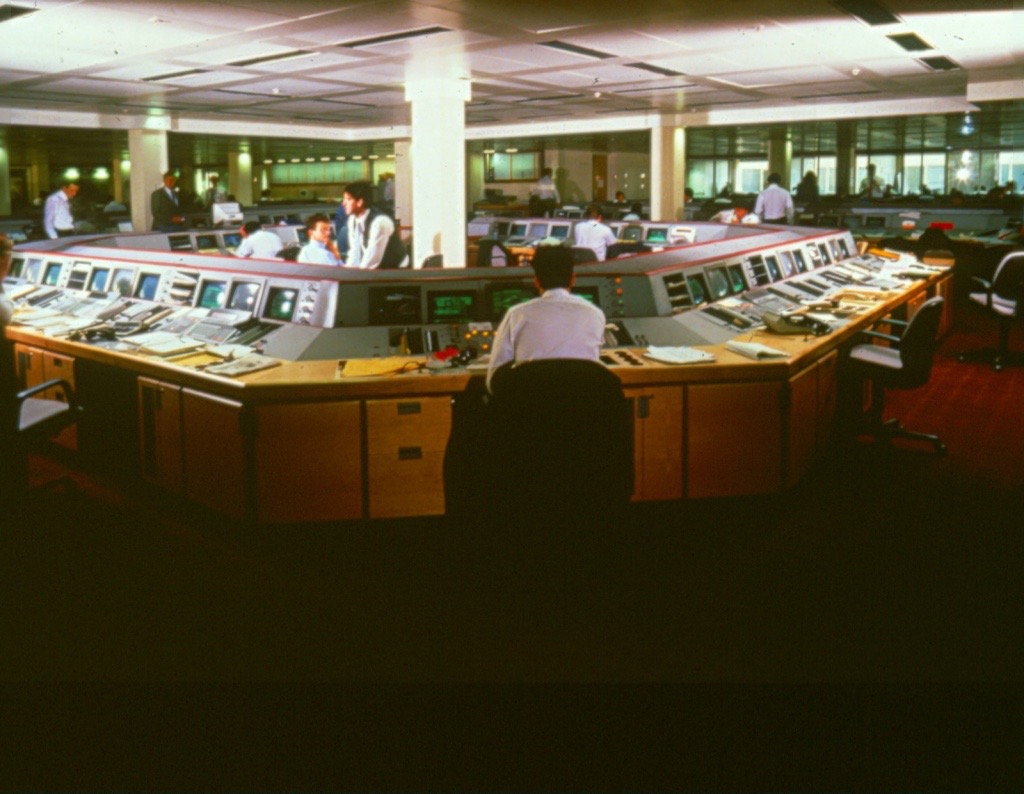
PHOTO: A Rich system in the late 1980s
- Rich adds the Triarch system to its product range which is the first client site Local Area Network. The first sales are made to Midland Montague in the UK and to a New York client. The design is very basic but does allow the “digital” adjective to be used. Reuters starts Triarch-related developments with its own application group. Servers are developed to process feeds of data and make them available to dealers for display and manipulation.
- With the advent of more powerful microprocessors, UNIX based workstations appear on the market from the likes of Sun. They are many times more powerful than PCs and their capabilities make them a favourite with traders and developers. They soon become the de-facto standard in trading rooms.
- The time to market debate gets more acrimonious. IDN is not moving quickly enough. The product development world rapidly turns into a debating society with longer and longer notes being exchanged. The focus seems to be on the inside rather than the outside. Essentially the issue is between centrally-led design and geographically-based development and marketing groups with strong ties. Luckily at this point competitors are not doing very much.
- IDN gives birth to the Logiciser, which puts paginated data from Monitor on IDN in logical RIC form and a Value Added System which begins to replicate the type of function currently done by the MMP for Monitor.
- IPSharp begins a project to develop a basic IDN terminal in the APL language using its considerable experience and expertise. It is potentially useful as it will run on standard PC hardware but proves to be yet another distraction and is eventually cancelled in 1990.
- Development groups become obsessed with searching for the silver bullet of radically improved development productivity. Fewer meetings and less specification changes may have helped more.
- The first Dealing installation is made in China. The continuing success of Dealing brings some design limits into uncomfortable proximity, particularly the limit of 4,000 user connections. A major project is started to overhaul the complete system.
- Latin America introduces direct satellite transmissions of news, pictures and market data via a small dish service using Intelsat 1.
- Country Reports is launched blending news with historical information covering 190 countries and territories over 90 days and more detailed information on 50 countries.
- Commissioning starts on a new high speed 1/2 Mb per second transatlantic satellite circuit.
- An agreement is concluded with the Chicago Metals Exchange to develop a global electronic trading system known as GLOBEX with introduction in mid-1989. GLOBEX will operate outside the regular trading hours of the open outcry market to provide 24-hour trading of products such as currency futures. It will use the Reuter Dealing Trading System (RDTS) - the proposed generic trading platform - which is now in design in New York. However the specification is far from generic and it actually turns into a separate large scale project alongside a not yet working forex matching application with all the obvious ramifications of cost and dilution of focus. It is also the first example of Reuters acting as a turnkey systems provider to an outside customer which requires a different set of skills.
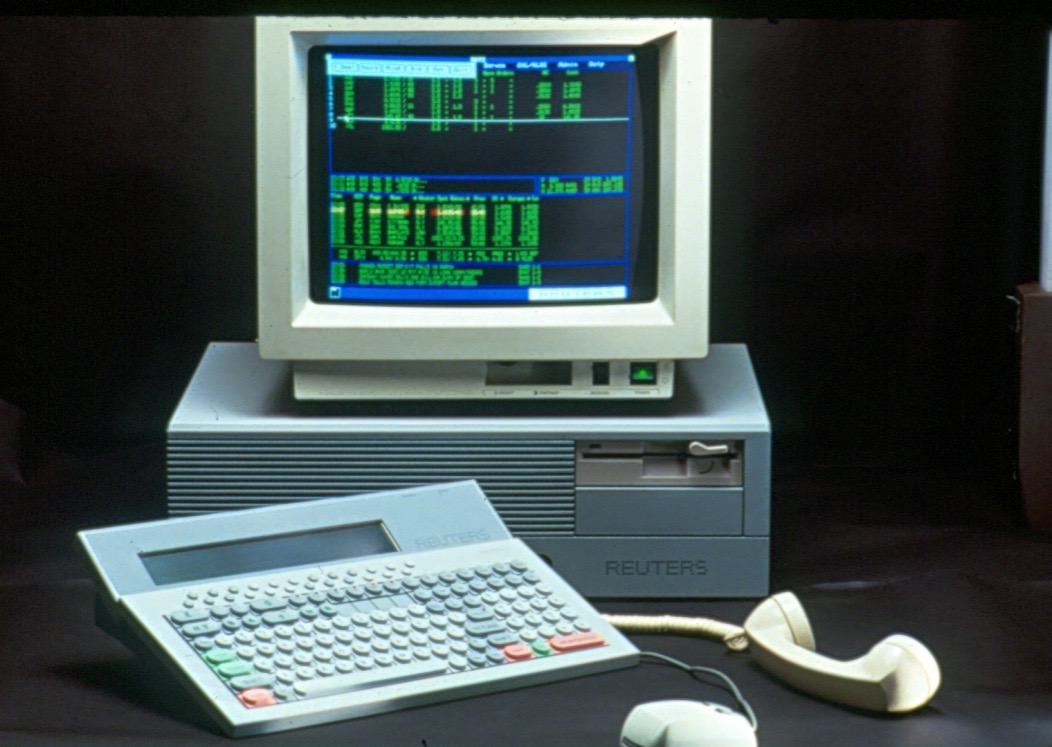
PHOTO: Early RDTS screen
 and Mark Tompsett at Westhorpe House Marlow home of Hovland Business Systems and Client Systems Development. Tompsett's grandmother had lived in the house.jpg) Hovland and later much of client site and Triarch-related developments take up residence in a converted country manor house near Marlow, west of London. They are nicknamed Trekkies. The view of the extensive landscaped grounds from some offices is apparently very soothing.
Hovland and later much of client site and Triarch-related developments take up residence in a converted country manor house near Marlow, west of London. They are nicknamed Trekkies. The view of the extensive landscaped grounds from some offices is apparently very soothing.- Half of Reuters staff are now technical and 45 per cent in Europe have been with the company less than two years.
PHOTO: David Kirby (L) and Mark Tompsett at Westhorpe House, Marlow, home of Hovland Business Systems and Client Systems Development. Tompsett's grandmother had lived in the house
- IDR commences commercial production of an Intel 386-based personal computer/work station. It is said to have the smallest case on the market but is up against some very large competitors. This evolves to a 486 processor with the addition of a custom graphics chip and is sold to customers other than Reuters. Applications quoted include engineering, publishing, factory automation, educational establishments and even hairdressers’ salons. The workstation is also the engine for an imaging system with integrated full colour image processing, multiple windows and still video images, graphics, text and a full motion video window. In fact anything you want. More staff are taken on by IDR for manufacturing but Rich loses staff as the digital world takes hold and video switching is phased out.
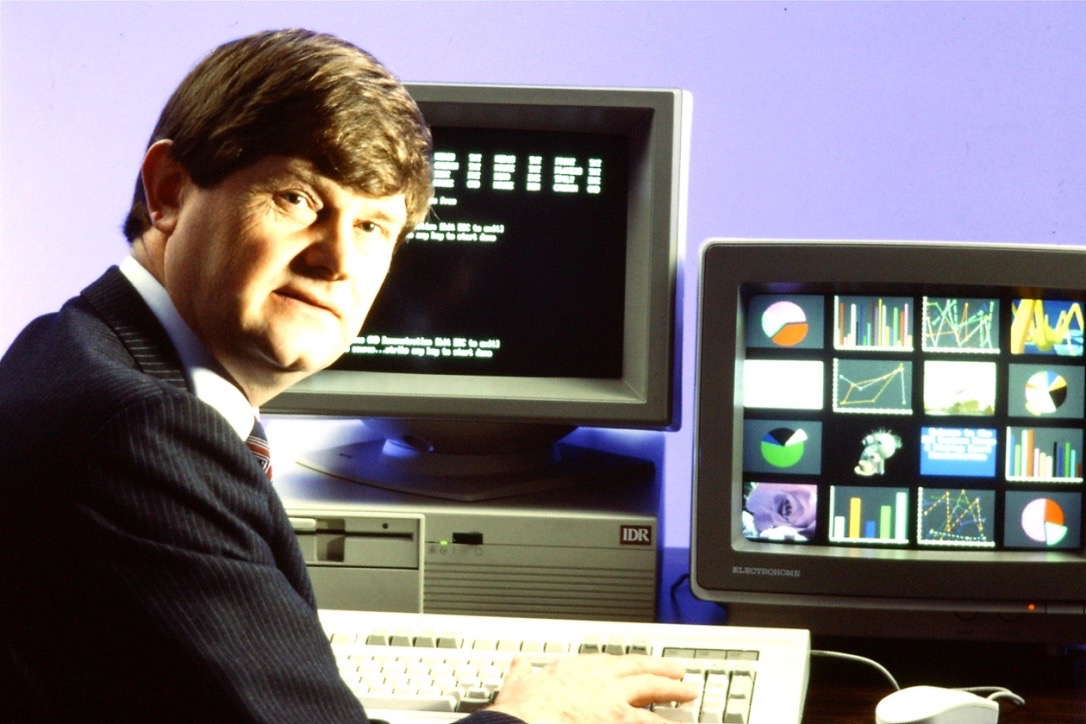
PHOTO: David Russell, IDR president, with IDR386 and Imaging System
- Reuters’ telecommunications policy is stated to be the use of terrestrial links as a primary communications mechanism because of the inherent delay in satellite transmissions. No-one has told Glen Renfrew though.
- Reuters reorganises into three geographic areas and five separate development and product areas. The old geographic structure for development is mostly dismantled, except for Asia. The five major product areas are information, media, trading room systems, historical information and transactions. Each has a product group leader who oversees the marketing and development of products through geographies and subsidiaries. Four of the product group leaders report to two area managers so geographical agendas can still conflict with global priorities.
- Historical information starts the task of making sense of Finsbury Data services and IPSharp databases and rationalising delivery mechanisms. Conway’s law quoted in the introduction (Organisations that design systems are constrained to produce designs that are copies of the communications structures of those organisations) is never more apparent as information products do little to help them.
- The IDN logjam becomes a major problem and Renfrew intervenes. He demands proof that IDN can advance and specifically carry news, contributed data and access remote databases over a single line by the end of the year. Surprisingly it does make some progress by cutting back on the marketing specifications of the day and shows what a little focus can achieve.
- The Dealing project to replace the old PDP/8 Dealing terminal with a PC environment is finally cancelled after four years of fruitless endeavour. It shows what no focus can achieve. Luckily a Dealing equivalent to the Advanced Reuter Terminal, produced by an outside contractor, is close to providing a solution by upgrading the look and feel of Dealing whilst adding useful extra features such as automatic deal ticket production. It uses LAN technology allowing other services to be accessed and new applications to be offered.
- A technical review concludes that the Automated Matching System, now known as the Dealing 2000 project, is getting increasingly complex and that time scales are at risk. There are major knowledge gaps in how operable and performant the various components are as many are new to Reuters (e.g. ADA programing language, Sybase database). The review points out that it can be up to two years from a first demonstration to revenue, e.g. IDN end-to-end data. In spite of this a launch date in 1989 is announced.
- A Monitor end-of-life project is put in hand to initiate a Monitor-style service on IDN and start the process of close down. There is some resistance to a forced swap out of Monitor, particularly from Asia. A clever box is developed to enable connection of old Monitor terminals to IDN thus avoiding a massive forced swap-out whilst continuing to provide a Monitor-style service.
- After more than 15 years and not long after the announcement of its new workstations, IDR closes and production is moved to Rich. The assets are auctioned off and some residual development continues at Hauppauge. An era comes to an end. This is all inevitable as Reuters decides to partner more closely with Intel and avoid the huge investment required to stay in the PC R&D race.
- The ART 2000 is launched offering Equities 2000 with various applications in the package. It has no technical relationship to the original ART other than it is also based on a (newer) Microsoft Windows platform (Version 2.0). It uses standard PC hardware with a new interface card for connection to IDN. It is marketed as the information terminal of the future and sets a whole new standard in technology application as well as user features. The cost per connection is many times that of an old style terminal controller which is initially rather intimidating. It becomes known as THE Reuter Terminal (RT).

PHOTO: ART-2 on IDR 386
- Biggest trading room order ever (in excess of £9 million) is received from NatWest Bank for a 400-position Triarch. Unfortunately the Sun workstations configured have insufficient power and have to be replaced after purchase but before installation which delays the project and adds enormously to the cost.
- A project is established to provide a rapid search capability for news. It uses a proprietary hardware system known as a DAP (Distributed Array Processor). It evolves into Newsyear2000 and lasts some time in spite of the proprietary nature of the technology. An early Google.
- A Text Retrieval Action Group is formed with high profile members to try to address the developing pickle of accessing news.
- The story of video and keyboard switching which started in 1979 concludes with the launch of PRISM (Programmable Integrated Switching Module). It is based on the keyboard hub which has turned into the most successful video switching system in the small-to-medium dealing room sector. PRISM allows a single keyboard to control up to four colour screens and as many as 12 other monochrome screens, thus allowing dealers to access many information sources cost effectively.
- Rack mounted PCs are now a regular feature in Dealing rooms avoiding the jumble of boxes as PCs become an essential part of the configurations. One contributor to the Chronology remembers a presentation to a client on a proposed Trading Room upgrade. This involves the installation of a full rack of PCs to provide the requested functionality but the rack is way above the permitted floor loading for the Trading Room. Luckily it is only a proposal.
- Matif (Marché à Terme Internationale de France), Europe’s leading futures exchange by volume, joins the GLOBEX club and will also trade its products over the network.
- The delays to Automated Matching, renamed Dealing 2000, are cleverly disguised by hijacking the new unreleased Dealing conversational intelligent terminal and announcing it as D2000 Phase 1 or D2000-1. Matching now becomes Dealing 2000 Phase 2 or D2000-2.
- The dealing development team deliver a number of major improvements. A new subscriber line protocol is designed and implemented to increase the efficiency of the client connection to the data centre particularly over poor quality circuits and satellites. Secondly addresses of frequently used counterparties are cached locally to the Terminal Controller (both PDP/8 and D2000-1) which avoids constant requests back to the centrally-based service machine. At the same time network capacity is dramatically increased by the introduction of extra network nodes and inter node connections. This also helps guard against the common occurrence of poor quality international circuits in many geographies. These actions contribute to an order of magnitude improvement in service quality though the geographies do not always welcome the extra costs of the circuits that they must bear.
- Dealing 2000-1 goes live, at Chemical Bank, in the form of a new terminal with enhanced features such as four simultaneous conversations. It adds a deal ticket capability. A good example of where outside consultants can add tremendous value without having to get involved in the intricacies of global networks. The original SWM network is slowly re-engineered behind the scenes to replace the ageing components with slicker software and MicroVAXs. The original host machines are also replaced with VAXs at this point, raising the capacity of the system from the original 4,000 to 100,000 users. More work needs to be done particularly to remove the vulnerability to a technical centre location failure but now, eight years after launch, little remains of the original system. The clients never know.
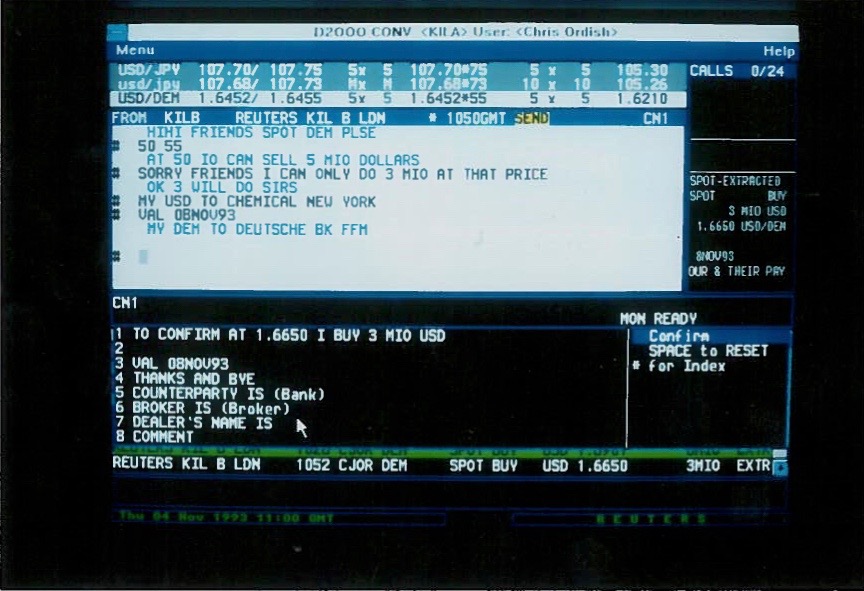
PHOTO: Dealing 2000-1
- Reuters orders hardware in volume from Intel instead of IDR for the first time. The deal is worth $30 million. The job of specifying what needs to be manufactured falls to engineering development - a far cry from when they did it all themselves.
 Maggie Stone Fiona Crabtree Sarah Dunn and Janet Stewart.jpg) Money 2000 is announced for IDN. It replaces International Money Rates on Monitor, a major revenue earner. The addition of the requisite systems on IDN to replicate the necessary functionality was executed in 15 months, which isn’t bad really. With contributed data in logical format a user can now retrieve a “chain” of quotes from competitive market makers with a single retrieval.
Money 2000 is announced for IDN. It replaces International Money Rates on Monitor, a major revenue earner. The addition of the requisite systems on IDN to replicate the necessary functionality was executed in 15 months, which isn’t bad really. With contributed data in logical format a user can now retrieve a “chain” of quotes from competitive market makers with a single retrieval.
PHOTO: Money 2000 launch team in 1989 (L-R) Maggie Stone, Fiona Crabtree, Sarah Dunn, Janet Stewart
- However the problem remains that IDN is fundamentally a broadcast and retrieval system with large scale inputs, e.g. exchanges. Monitor is fundamentally a retrieval system with a quasi-transactional component allowing medium scale and individual inputs. The differences remain to be bridged if Monitor is to be closed down.
- Quality Improvement Programmes become the mantra of the day. Everyone has to have one.
- Earthquake-prone Tokyo takes over from Hong Kong as the main Asia area technical centre which is opened by the managing director.
- The London Docklands technical centre is opened by chairman Sir Christopher Hogg.
- The first SGS system to be switched off is de-commissioned in Amsterdam.
- The biggest data feed ever, the DFT or Marketfeed 2000, is sold to Fidelity Investments. It takes the datafeed argument to new levels as it offers a large chunk of the IDN database down a 56kbs link. Some sales follow to those getting into program trading. It uses the Marketfeed protocol developed originally for SDS-2. In the hurry to get the device to market, the way data is presented to the client is not completely thought through. It will be a source of migration headaches for years to come on this and other IDN-connected datafeed products.
- Triarch is tidied up in the form of a relaunch as Triarch 2000. Source servers, gateway servers and application servers can be combined to feed a Triarch Intelligent workstation - the Triarch equivalent of an ART. The details of the protocols between the servers and the workstations is still messy and requires more work if real freedom for application developers is to be achieved.
- A major initiative starts to reduce the scale and complexity of operating the global IDN network. The rationalisation proposed is to site operationally intensive systems in one of the three main centres (London, Hauppauge, Tokyo) reducing all other centres to “operations free” zones. This is because of the huge capital expenditure multiplying factor when introducing equipment upgrades for traffic and terminal number increases. One approach investigated is to deploy LAN bridge technology to extend the main data centre Ethernet to the secondary centres. This eliminates many systems at secondary locations.
- The fundamental problem is to break the link between growth in terminal numbers and traffic rates and growth in communications and data centre costs. A problem which no doubt persists in the business model of Thomson Reuters to this day.
- Glen Renfrew returns with a vengeance to his theme of using satellite transmission direct to local storage devices close to the client or preferably on the client premises. He argues that this is the only way to break the link between growth and cost and that technology has moved on and the approach is now feasible. The problem is that the traffic rates have increased and so has the database size to be broadcast - assuming all IDN-connected clients need everything - which is the model followed so far. The discussions spawn a caching system development which will store a useful chunk of the database close to the client. Asia starts development of a new more powerful direct broadcast system for regional deployment which can handle greater volumes of traffic than the current versions. It also starts a separate version of a caching system for Japanese application. Although the caching systems can’t handle the full IDN stream of data, a backlink is proposed which will retrieve data that is not available in the main broadcast. This is very similar to two-way Rowgrabber abandoned in 1984. The design problems remain the same but at least technology has moved on from homegrown hardware.
- The Carnegie Group system started in 1986 finally works well enough to automatically categorise news items for Country Reports.
- Company Newsyear is launched with 365 days of news.
- A new database unit is established at Tiverton, Devon to input and polish various classes of historical information. It is convenient to a certain executive’s weekend house and profits from a useful pool of graduates who do not wish to relocate from a pleasant English West Country environment.
- With IDN becoming more widespread and useful, Monitor “Singling" is planned which will progressively dismantle the dualed network set up in 1984. Second-hand PDP-11/70 anyone - one careful user?
- Reuters take a 34 per cent stake in a Sydney-based software company (ESL) with some interesting graphics applications. It proves to be an important contributor to the product line and provides a new destination for development executives, at least for those who remember their visas.
- « Previous
- Next »
- 8 of 18
